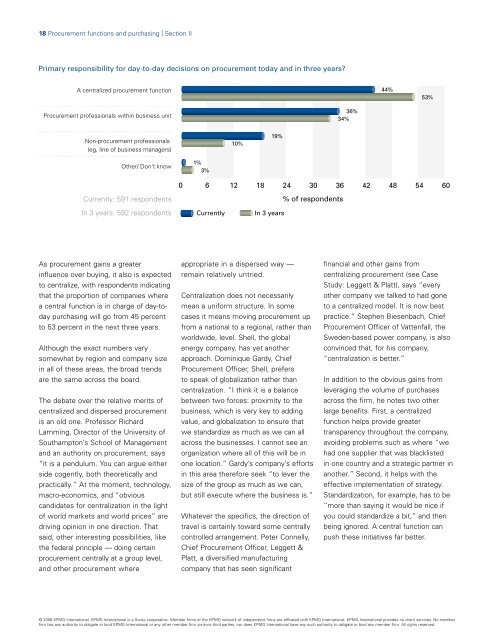Beyond purchasing
Create successful ePaper yourself
Turn your PDF publications into a flip-book with our unique Google optimized e-Paper software.
18 Procurement functions and <strong>purchasing</strong> | Section II<br />
Primary responsibility for day-to-day decisions on procurement today and in three years?<br />
A centralized procurement function<br />
44%<br />
53%<br />
Procurement professionals within business unit<br />
36%<br />
34%<br />
Non-procurement professionals<br />
(eg, line of business managers)<br />
10%<br />
19%<br />
Other/ Don't know<br />
Currently: 591 respondents<br />
In 3 years: 592 respondents<br />
1%<br />
3%<br />
0 6 12 18 24 30 36 42 48 54<br />
Currently<br />
In 3 years<br />
% of respondents<br />
60<br />
As procurement gains a greater<br />
influence over buying, it also is expected<br />
to centralize, with respondents indicating<br />
that the proportion of companies where<br />
a central function is in charge of daytoday<br />
<strong>purchasing</strong> will go from 45 percent<br />
to 53 percent in the next three years.<br />
Although the exact numbers vary<br />
somewhat by region and company size<br />
in all of these areas, the broad trends<br />
are the same across the board.<br />
The debate over the relative merits of<br />
centralized and dispersed procurement<br />
is an old one. Professor Richard<br />
Lamming, Director of the University of<br />
Southampton’s School of Management<br />
and an authority on procurement, says<br />
“it is a pendulum. You can argue either<br />
side cogently, both theoretically and<br />
practically.” At the moment, technology,<br />
macroeconomics, and “obvious<br />
candidates for centralization in the light<br />
of world markets and world prices” are<br />
driving opinion in one direction. That<br />
said, other interesting possibilities, like<br />
the federal principle — doing certain<br />
procurement centrally at a group level,<br />
and other procurement where<br />
appropriate in a dispersed way —<br />
remain relatively untried.<br />
Centralization does not necessarily<br />
mean a uniform structure. In some<br />
cases it means moving procurement up<br />
from a national to a regional, rather than<br />
worldwide, level. Shell, the global<br />
energy company, has yet another<br />
approach. Dominique Gardy, Chief<br />
Procurement Officer, Shell, prefers<br />
to speak of globalization rather than<br />
centralization. “I think it is a balance<br />
between two forces: proximity to the<br />
business, which is very key to adding<br />
value, and globalization to ensure that<br />
we standardize as much as we can all<br />
across the businesses. I cannot see an<br />
organization where all of this will be in<br />
one location.” Gardy’s company’s efforts<br />
in this area therefore seek “to lever the<br />
size of the group as much as we can,<br />
but still execute where the business is.”<br />
Whatever the specifics, the direction of<br />
travel is certainly toward some centrally<br />
controlled arrangement. Peter Connelly,<br />
Chief Procurement Officer, Leggett &<br />
Platt, a diversified manufacturing<br />
company that has seen significant<br />
financial and other gains from<br />
centralizing procurement (see Case<br />
Study: Leggett & Platt), says “every<br />
other company we talked to had gone<br />
to a centralized model. It is now best<br />
practice.” Stephen Biesenbach, Chief<br />
Procurement Officer of Vattenfall, the<br />
Swedenbased power company, is also<br />
convinced that, for his company,<br />
“centralization is better.”<br />
In addition to the obvious gains from<br />
leveraging the volume of purchases<br />
across the firm, he notes two other<br />
large benefits. First, a centralized<br />
function helps provide greater<br />
transparency throughout the company,<br />
avoiding problems such as where “we<br />
had one supplier that was blacklisted<br />
in one country and a strategic partner in<br />
another.” Second, it helps with the<br />
effective implementation of strategy.<br />
Standardization, for example, has to be<br />
“more than saying it would be nice if<br />
you could standardize a bit,” and then<br />
being ignored. A central function can<br />
push these initiatives far better.<br />
© 2008 KPMG International. KPMG International is a Swiss cooperative. Member firms of the KPMG network of independent firms are affiliated with KPMG International. KPMG International provides no client services. No member<br />
firm has any authority to obligate or bind KPMG International or any other member firm visàvis third parties, nor does KPMG International have any such authority to obligate or bind any member firm. All rights reserved.



